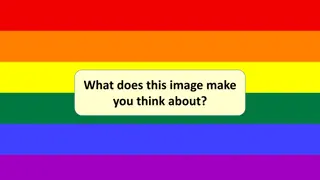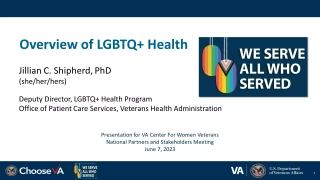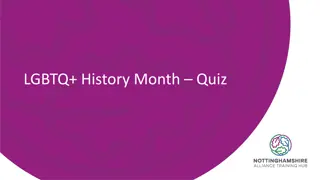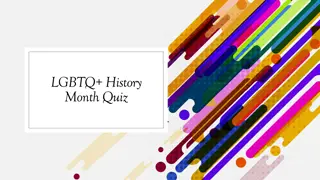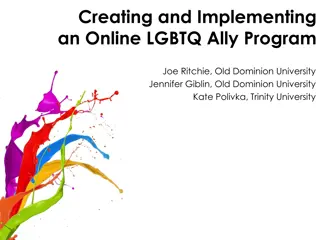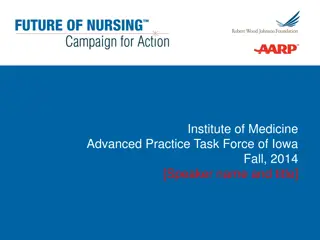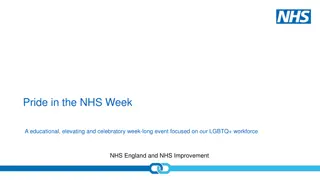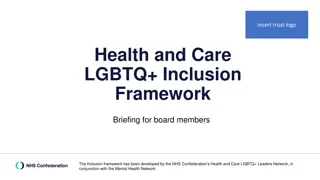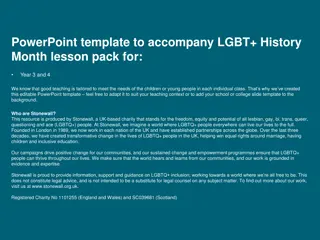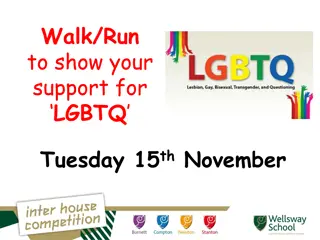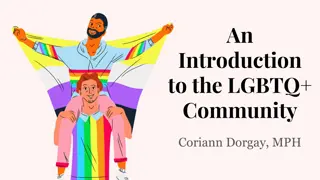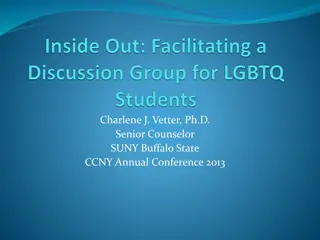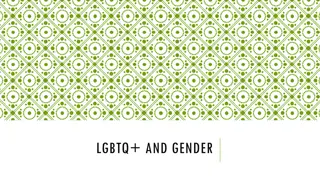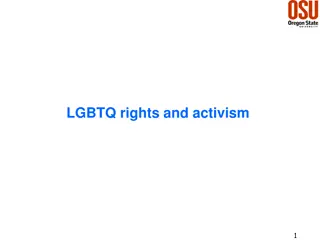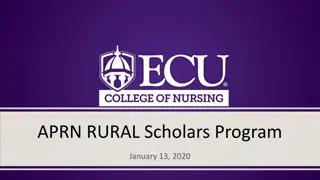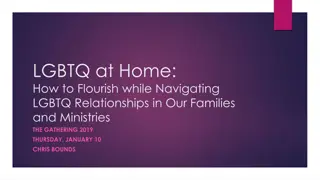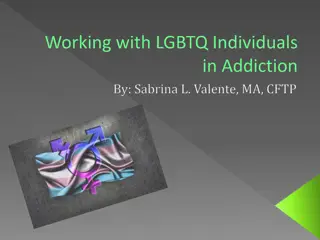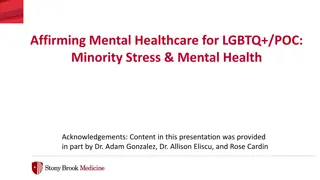Understanding LGBTQ+ Definitions and Terminology for Nurse Educators
Explore the definitions and terminology related to the LGBTQ+ community, including terms like lesbian, gay, bisexual, transgender, and queer. Learn about gender identity, sexual orientation, and the importance of respectful communication in nursing education. Gain insights into LGBTQ+ population statistics, national organization position statements, and current research to enhance understanding and support for LGBTQ+ individuals.
Uploaded on Sep 17, 2024 | 0 Views
Download Presentation

Please find below an Image/Link to download the presentation.
The content on the website is provided AS IS for your information and personal use only. It may not be sold, licensed, or shared on other websites without obtaining consent from the author. Download presentation by click this link. If you encounter any issues during the download, it is possible that the publisher has removed the file from their server.
E N D
Presentation Transcript
Using Respectful Communication with LGBTQ+ People: Background for Nurse Educators
Objectives: Background Upon completion of the PowerPoint session, the learner will be able to: 1. Define terminology used by LGBTQ+ people. 2. Describe the population statistics of the LGBTQ+ population. 3. Review LGBTQ+ position statements from national organizations. 4. Examine current research for nursing education and LGBTQ+ people.
LGBTQ+ Definitions (National LGBT Health Education Center, 2020) Lesbian: A sexual orientation that describes a woman who is primarily emotionally and physically attracted to other women (p. 6). Gay: A sexual orientation describing people who are primarily emotionally and physically attracted to people of the same sex and/or gender as themselves. Commonly used to describe men who are primarily attracted to men, but can also describe women attracted to women (p. 3). Bisexual: A sexual orientation that describes a person who is emotionally and physically attracted to women/females and men/males. Some people define bisexuality as attraction to all genders (p. 2).
LGBTQ+ Definitions Continued Transgender: Describes a person whose gender identity and sex assigned at birth do not correspond based on traditional expectations; for example, a person assigned female sex at birth who identifies as a man; or a person assigned male sex at birth who identifies as a woman (p. 9). Queer: An umbrella term describing people who think of their sexual orientation or gender identity as outside of societal norms. Some people view the term queer as more fluid and inclusive than traditional categories for sexual orientation and gender identity (p. 7).
Match the Terminology to the Definition On the following slide, match the terms in purple to the correct definitions in gray. Definitions are from the National LGBTQIA+ Health Education Center, 2020.
The process of making social, legal, and/or medical changes to recognize, accept, and express one s gender identity Questioning Describes a person whose gender identity falls outside of the traditional gender binary structure of girl/woman and boy/man Asexual Non- binary A person whose gender identity is consistent in a traditional sense with their sex assigned at birth Cisgender Describes a person who is unsure about or exploring their sexual orientation and/or gender identity Gender Affirmation Describes a person who experiences little or no sexual attraction to others Gender Identity A person s inner sense of being a girl/woman/female, boy/man/male, something else, or having no gender
The process of making social, legal, and/or medical changes to recognize, accept, and express one s gender identity Questioning Describes a person whose gender identity falls outside of the traditional gender binary structure of girl/woman and boy/man Asexual Non- binary A person whose gender identity is consistent in a traditional sense with their sex assigned at birth Cisgender Describes a person who is unsure about or exploring their sexual orientation and/or gender identity Gender Affirmation Describes a person who experiences little or no sexual attraction to others Gender Identity A person s inner sense of being a girl/woman/female, boy/man/male, something else, or having no gender
Communication and Updated Terminology Outdated and Insensitive Updated, Respectful Terms Assigned female/male at birth Biological female/male Cross-sex hormone therapy; hormone replacement therapy Gender-affirming hormone therapy Intersex Disorders/differences of sex development Gender non-binary Gender nonconforming Sexual orientation Sexual preference/lifestyle Female-to-male (FTM) and Male-to-female (MTF) Transgender man and transgender woman
LGBTQ+ Demographics In 2019, 11 million identify as lesbian, bisexual, gay or transgender (National Academy of Sciences, Engineering and Medicine, 2021). The Human Rights Campaign (2021) estimates 20 million and more. Gallup 2020: Percent who identify as LGBT (Jones, 2021) o Bisexual 54.6% o Gay 24.5% o Lesbian 11.7% o Transgender 11.3% LGBTQ+ population substantially increased over the past decade. o Growth driven by the youngest generations, women, bisexual and racial/ethnic minorities (Jones, 2021). o 1.7 million youth of high school age identify as LGBTQ+ (ANA Ethics Advisory Board, 2018).
LGBTQ+ Experience In 2016, the National Institutes of Health (NIH) formally designated sexual and gender minorities as a health disparity population (National Academy of Sciences, Engineering and Medicine, 2021) Unfortunately, many experience stigma, discrimination, and violence where they live, work, play, and pray (National Academy of Sciences, Engineering and Medicine, 2021, p. 20). Disparities are growing rather than narrowing for several key health indicators (Fish et al., 2017)
LGBTQ+ Experience LGBTQ+ populations avoid or delay treatment due to bias and bigotry. Healthcare needs are unmet due to lack of acceptance, knowledge or understanding by healthcare professionals (Alpert et al., 2017; Eickhoff, 2021). For nursing, the lack of LGBTQ+ education is the largest barrier to the delivery of culturally congruent healthcare.
ANA Position Statement: Nursing Advocacy for the LGBTQ+ Populations (2018) Nurses must provide culturally congruent care and advocacy for LGBTQ+ people. ANA condemns discrimination based on sexual orientation, gender identity and/or expression in healthcare (ANA Ethics Advisory Board, 2018, p.1) Continued stigma and discrimination impedes access to essential care ultimately leading to poor outcomes and increased morbidity and mortality. ANA Code of Ethics is clear, the nurse practices with respect and compassion for the dignity and worth of every person.
NLN Vision Series: Achieving Diversity and Meaningful Inclusion in Nursing Education (2016) The NLN is committed to the education of exemplary nurses who value and embody the richness of difference and inclusion to help advance the health of the nation and the global community (p.1). Critical need to increase content in nursing education curricula enhancing healthcare parity for LGBTQ+ populations.
LGBTQ+ Research Most of research on LGBTQ populations centered on healthcare needs, healthcare delivery and barriers to care (Eickhoff, 2021). Qualitative study with LGBTQ+ regarding healthcare professionals found lack of knowledge and need for curricular integration in educational institutions (Alpert et al., 2017).
LGBTQ+ Research LGBTQ faculty in baccalaureate nursing education programs were more aware of and prepared to address health concerns of the LGBTQ population than their heterosexual colleagues (Lim et al, 2015). Nursing student s attitudes toward the LGBTQ+ populations is impacted by knowledge (Lim and Hsu, 2016).
References Alpert, A., Cichoski-Kelly, E., Fox, A. (2017). What lesbian, gay, bisexual, transgender, queer, and intersex patients say doctors should know and do: A qualitative study. Journal of Homosexuality, 64(10), 1368-1389. https://doi.org/10.1080/00918369.2017.1321376 ANA Ethics Advisory Board, (November 19, 2018) "ANA Position Statement: Nursing Advocacy for LGBTQ+ Populations" OJIN: The Online Journal of Issues in Nursing, 24, (1). DOI: 10.3912/OJIN.Vol24No01PoSCol02 Eickhoff, C. (2021). Identifying gaps in LGBTQ health education in Baccalaureate undergraduate nursing programs, Journal of Nursing Education, 60(10), 552-558. doi:10.3928/01484834-20210729-01
References Fish, J., Watson, R., Porta, C., Russell, S., & Sawyer, E. (2017). Are alcohol- related disparities between sexual minority and heterosexual youth decreasing? Addiction, 112(11), 1931-1941. doi:10.1111/add.13896. Jones, J. (2021). LGBT identification rises to 5.6% in latest U.S. estimate. https://news.gallup.com/poll/329708/lgbt-identification- rises-latest-estimate.aspx Lim, F., & Hsu, R. (2016). Nursing students attitudes toward lesbian, gay, bisexual, and transgender persons: An integrative review, Nursing Education Perspectives, 37(3), 114-152. doi:10.1097/01.NEP.0000000000000004
References Lim, F., Johnson, M., & Eliason, M. (2015). A national survey of faculty knowledge, experience, and readiness for teaching lesbian, gay, bisexual, and transgender health in Baccalaureate nursing programs. Nursing Education Perspectives,36(3), 144-152. doi:10.5480/14-1356 Morris, B. (2009). History of lesbian, gay, bisexual and transgender social movements. American Psychological Association, 1-12. https://www.apa.org/pi/lgbt/resources/history National Academy of Sciences, Engineering and Medicine. (2021). Understanding the well-being of LGBTQI+ populations: Demography. https://www.nap.edu/resource/25877/Demography-Brief.3.pdf
References National League for Nursing. (2016). NLN vision series: Achieving diversity and meaningful inclusion in nursing education. https://www.nln.org/docs/default-source/uploadedfiles/about/vision- statement-achieving-diversity.pdf?sfvrsn=85a4d30d_0 National LGBTQIA+ Health Education Center. (2020). LGBTQIA+ glossary of terms for health care teams. https://www.lgbtqiahealtheducation.org/publication/lgbtqia-glossary-of- terms-for-health-care-teams/ The Human Rights Campaign Foundation. (2021). We are here: Understanding the size of the LGBTQ+ community. https://hrc-prod- requests.s3-us-west-2.amazonaws.com/We-Are-Here-120821.pdf


